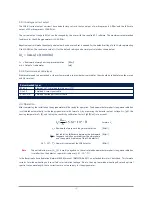
6.1 Spectral range
The spectral properties of the pyrgeometer are mainly determined by the filter characteristics of the silicon window and the
coatings. The application is primarily to measure long-wave downward atmospheric radiation. The spectral range is from 4.5 to
42 µm, where most of this radiation is present.
Pyrgeometer spectral window properties
The atmosphere is transparent to long-wave radiation emitted by the Earth’s surface in certain wavelength intervals, particularly
within a spectral range of approximately 8 to 14 µm. This is called the ‘atmospheric window’. Within this spectral range the Earth
is able to maintain an equilibrium temperature by losing a certain quantity of heat gained each day from the sun.
The sun radiates approximately as a blackbody at an equivalent temperature of 5770K. Almost 99% of its emitted energy is
contained in wavelengths less than 4µm, called short-wave radiation. The equivalent radiant temperature of the Earth’s surface
is about 275K. More than 99% of this energy is emitted at wavelengths greater than 3 µm and is called long-wave, thermal, or
infrared radiation.
Downward long-wave radiation is a result of atmospheric re-emission. Re-emission is the reversible effect of absorption of
long-wave radiation emitted by the Earth and by chemical elements such as water (H₂O), Oxygen (O₂), Ozone (O₃), Carbon
dioxide (CO₂), etc. These elements are the main emitters of long-wave radiation in the atmosphere. The remaining unabsorbed
portion of the Earth’s radiation escapes into outer space. Under clear skies an object can be cooled below ambient air tempera-
ture by radiative heat loss to the sky.
Observing the earth from outer space, a blackbody is seen in a range of 8 to 14 µm with a temperature of 14°C and outside this
wavelength range a blackbody of -60°C. Under clear sky conditions in a reverse direction, outer space can be observed in the
same spectral range.
Atmospheric radiation
6.2 Sensitivity
The radiometer thermopile sensitivity is mainly determined by the physical properties of the detector itself. The thermoelectric
power, thermal conductivity of the junctions and the overall dimensions of the sensing element are related to its sensitivity.
6. Pyrgeometer physical properties
Wavelenght [µm]
Transmittance [%]
100
50
0
1
10
100
SGR4 window transmittance
Amplitude
Wavelength [µm]
5
75°
60°
0°
90°
0
5
10
15
20
25
29






























